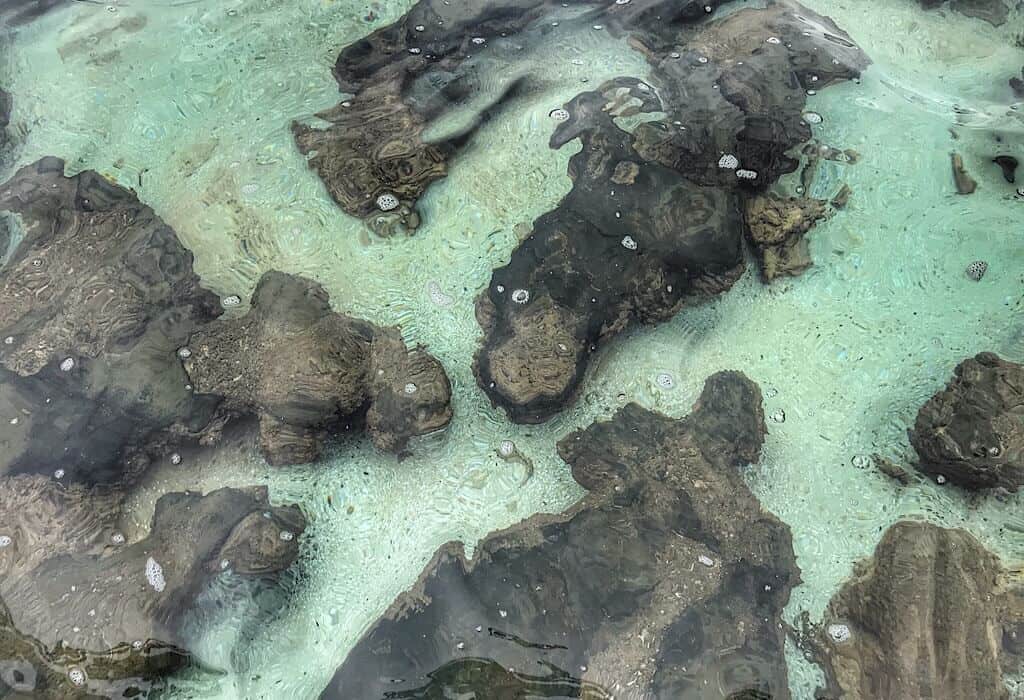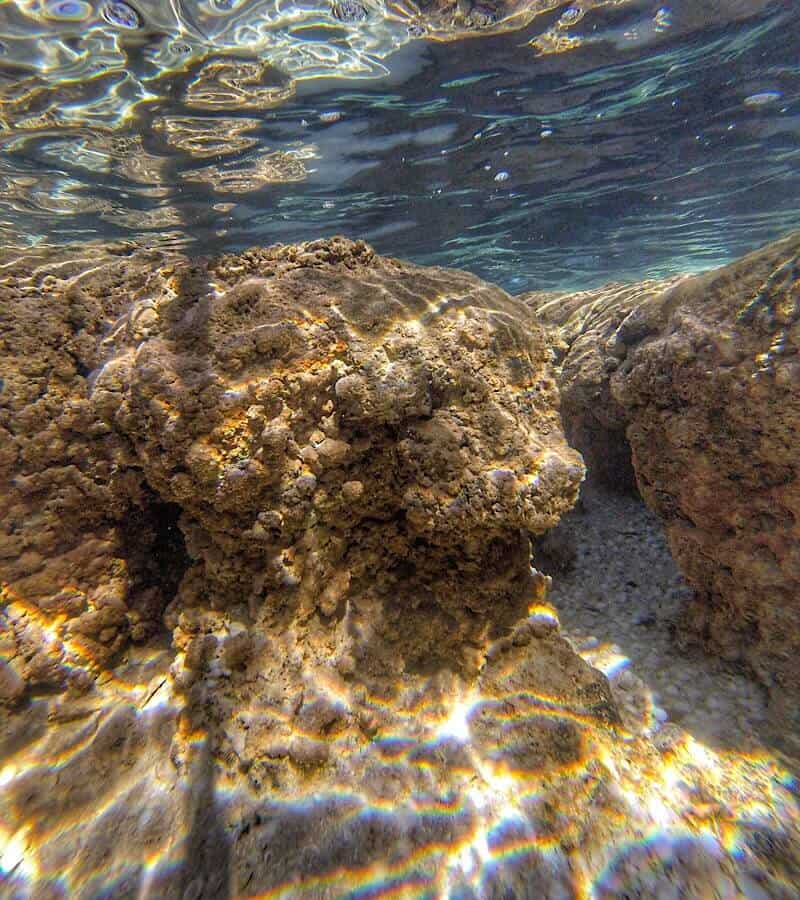From the boardwalk, I observed the strangest shoreline yet. Rounded mounds dotted the shallows breaking just above the waterline. As the lake grew deeper these mounds extended further under the water’s surface. What appeared to be perfectly shaped rocks were actually something alive.
Australia has fascinated me since my first morning when I woke to the beautiful song of the Australian magpie. The landscape from mountains to long, flat, endless roads have excited and filled me with joy. As if all that was not enough the culture is peaceful. It is built on trust and helping each other out.
After nine months here in Australia I’m still finding new things. Living rocks is one of them, found in only a few other places in the world. Australia has the greatest display and concentration, all found here on the west coast.
These rocks are an ancient microscopic jungle.

Thrombolites of Lake Clifton
As Trin and I travel I look for cool things to see and place a pin in our shared google map. Trin plans out our route and includes these stops along the way. One of the pins in our Western Australian map was Lake Clifton just south of Perth.
As we approached the lake I asked Trin if he knew anything about Lake Clifton.
“No,” he said. “It was one of your pins, what are we going to see here?”
“A shoreline filled with what looks like cool rounded rocks, but they are actually all alive.”
The thrombolites in Lake Clifton are clotted microbial communities and have been alive for about 2,000 years. I was admittedly excited to see these living fossils.
The “rocks” looked like mounds of clotted cream. Scientifically, thrombolites are referred to as being “clotted” bunches of bacteria working together. Each mound that we were seeing on the shoreline is a cyanobacterial colony. They are bacteria that have bound together with sediment to create living rocks.
Lake Clifton contains the largest lake-bound thrombolite reef in the southern hemisphere.

Lake Thetis
As Trin and I progressed north of Perth we stopped at Lake Thetis to see more of these living rocks. It is home to Thrombolites, Stromatolites, and blister mats. Many of the structures in this lake have been damaged, but the stromatolites are 3,500 years old and still alive.
There is also a large blister mat under the boardwalk where we walked. Blister mats are microbial mats that look like its namesake. They look like blister packs but are bacteria on the top layer of sediment, the oxygen they release creates tiny sand bubbles.



Hamelin Pool
On our way Perth we stopped to see the most diverse and abundant living stromatolite community in the world. , These stromatolite wonders rest along the shore of Hamelin Pool about 3.5 hours south of Perth.
Stromatolites are similar to thrombolites in that they are communities of bacteria and are photosynthetic. Unlike the clotting structure of the thrombolites, stromatolites grow in layers and are taller.
Water from the Indian Ocean flows into this bay and due to the hot and dry region, it evaporates quickly. There is also minimal rain and therefore freshwater scarcely flows into this bay. These two factors combined make the Hamelin Bay twice as salty as the open ocean.
Since creatures, like snails that like to eat cyanobacteria, cannot survive the hypersalinity, it makes the Hamelin Pool an ideal location for the living microscopic jungle of the stromatolites.


Beyond Appearance
The shorelines of Lake Clifton and Hamelin Pool were definitely unique stops along our path. They were all the more fascinating after I read some of the studies conducted on these living fossils. Without knowing more about them I probably would have seen the shoreline, thought it was cool, and walked away.
I was fascinated with each unique structure. Trin and I stared down into the water. They are a simple lifeform but have still survived thousands of years despite all the changes around them. Sometimes a simple life is more resilient.

The opportunity here that I had to observe these ancient living fossils has been a treasure.
I’ve said little about the unrest in my home country of the USA except to say that I support equality. I believe that all people should be treated with respect. As a white person, I am listening and learning. I’m processing. I have telephoned a few of my friends of African-American descent, friends whom I trust and respect, to ask them about their experience and to learn from them.
Sometimes the best opportunities are those that allow you to listen, observe, and seek to understand. Call a friend who may have experienced our culture differently than you and ask them how they have experienced the world.
Listening is a great opportunity, it can be a treasure that changes our view of the world for the better.

For more information about these ancient living structures see Chapter 6.1 Stromatolite Morphogenesis in Shark Bay, Western Australia & Thrombolites and stromatolites; two distinct types of microbial structures

Thanks, Bonnie, for continuing to bring to light treasures of the earth! As always, I’m fascinated by what you find and the information that comes along with it. God’s creation is truly astounding and his riches are unsearchable. Continue to stay safe as you wander!
Australia is constantly fascinating us too! I hope you are doing well.
I am mesmerized by these creatures. Never heard of them before. Also, I agree about listening. I try very hard to listen to both sides before jumping to a conclusion. I, too, have talked to some African-American friends of mine for their view on all this. Keep blogging. I love learning about different cultures and countries.
I have so much to learn too <3
Great post, Bonnie! I remember the stromatolites from my time in Western Australia. I am so envious (in a good way!) of you being there – it is so beautiful. One of the most amazing places I’ve ever visited. We are coming out of lockdown bit by bit here in the UK but it will be a while before I can book a flight anywhere.
I am very grateful to be in Western Australia right now. It’s cool that you also saw the stromatolites.
Glad to hear that lockdown is easing for you. I think it will take quite a while for world travels to fully open again.
Thank you for your article, it has been very helpful, but please be aware you should probably update that the driving time from Perth up to Hamelin Pool and Shark Bay is approx. 8 hours, not 3.5 hours. Thanks again.
Oh wow, Thank you. I just double checked my post and I did get the driving time wrong. It has been updated now. Thank you for the heads up!!